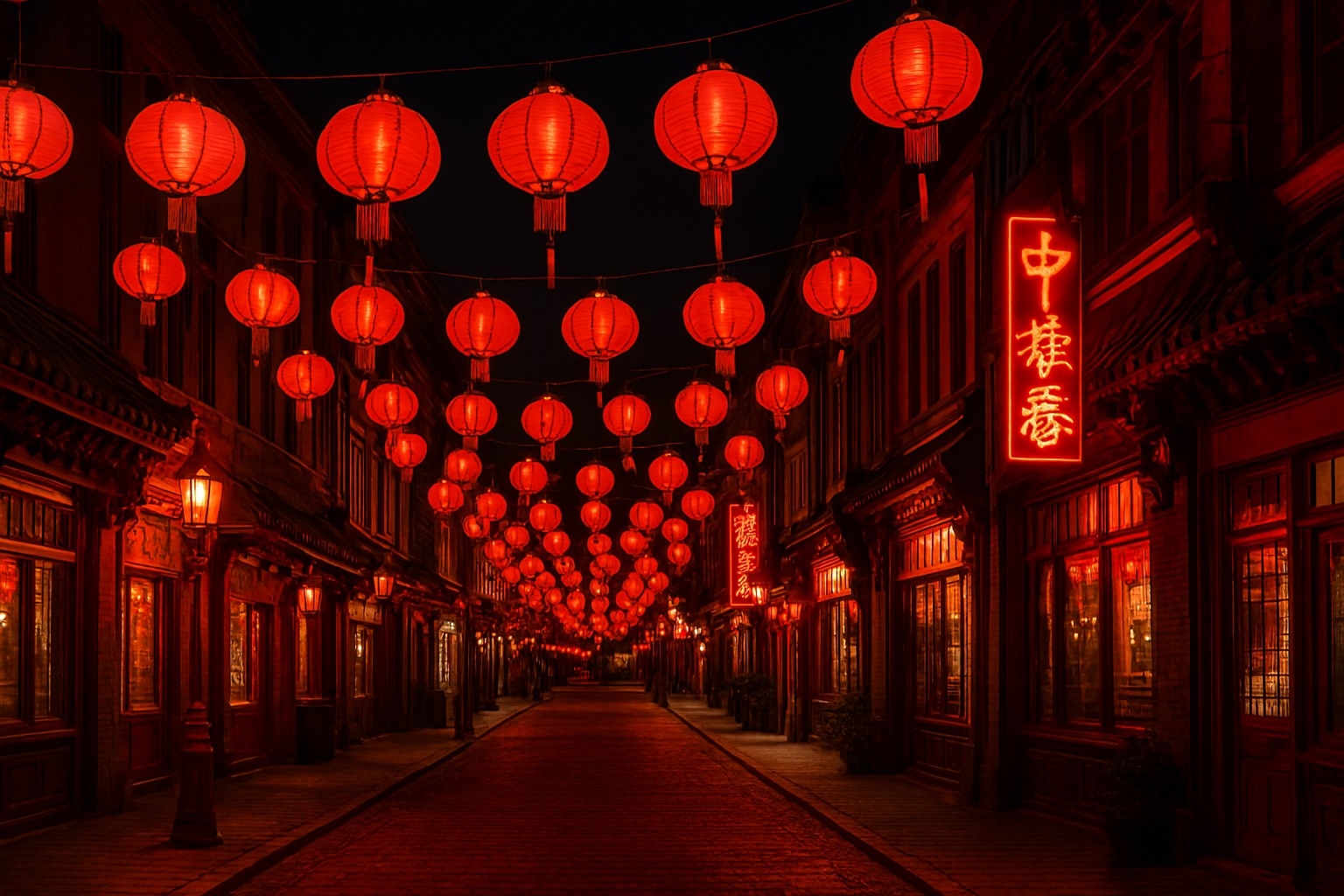
China Town Red represents far more than a simple color designation. This multifaceted term encompasses everything from premium fountain pen ink to cultural symbolism, from architectural design elements to linguistic expressions that bridge Eastern and Western traditions. Whether you’re a fountain pen enthusiast discovering the warm vibrancy of Chinatown Red ink, a cultural scholar exploring the symbolic power of red in Chinese communities, or someone curious about the deeper meanings behind everyday expressions, this comprehensive guide reveals the rich tapestry of contexts where “China Town Red” appears.
The significance of China Town Red extends across multiple domains: it’s a coveted ink color prized by collectors for its unique orange-leaning warmth, a cultural marker that adorns Chinatown gateways worldwide, and a linguistic bridge connecting the celebratory idiom “paint the town red” with distinctly Chinese interpretations of festivity and fortune. Understanding these interconnected meanings provides insight into how color, culture, and commerce intersect in our globalized world.
This exploration will take you through the historical origins and semantic variations of the term, examine the specific characteristics and performance of Chinatown Red as a fountain pen ink, delve into the cultural and symbolic interpretations of red in Chinese communities, and analyze contemporary trends and regional variations that continue to shape how we understand this vibrant concept.
Origin and Historical Context of China Town Red
Early Historical Roots
The term “China Town Red” emerges from the intersection of several distinct cultural and commercial traditions. The earliest recorded uses appear in fountain pen ink catalogs from European manufacturers, particularly Dutch companies like Akkerman, who began producing specialty inks inspired by global cultural themes in the mid-20th century. These manufacturers sought to capture the essence of international neighborhoods and cultural districts through color, creating inks that would evoke specific places and experiences for users.
The commercial adoption of “Chinatown Red” as a product name reflects a broader trend in specialty manufacturing where cultural geography influences product development. Unlike generic color names, Chinatown Red was designed to evoke specific visual and emotional associations with the vibrant red elements commonly found in Chinese cultural districts worldwide.
Historical documentation shows that the choice of red as the defining color for these cultural products wasn’t arbitrary. Red has held paramount importance in Chinese culture for over three millennia, serving as a symbol of good fortune, celebration, and prosperity. Early Chinese immigrants to Western cities naturally incorporated these traditional color associations into their new communities, creating the visual landscape that would later inspire commercial products.
Semantic Evolution and Multiple Meanings
The evolution of “China Town Red” as a term reveals fascinating semantic complexity. Initially, the phrase functioned primarily as a product descriptor for fountain pen ink, specifically referencing the warm, orange-tinged red color that manufacturers associated with Chinese cultural aesthetics. However, the term has expanded to encompass broader cultural and symbolic meanings.
In contemporary usage, China Town Red functions across several distinct semantic fields. As a commercial product, it refers to specific ink formulations with particular color characteristics and performance qualities. As a cultural symbol, it represents the visual identity of Chinese diaspora communities worldwide. As an aesthetic concept, it embodies a specific approach to color that balances traditional Chinese symbolism with contemporary Western sensibilities.
The linguistic journey of this term also reflects changing attitudes toward cultural representation in commercial products. Earlier iterations of culturally-themed products often relied on stereotypical associations, while contemporary versions of Chinatown Red demonstrate more nuanced understanding of cultural authenticity and respect for traditional symbolism.
Chinatown Red as Premium Fountain Pen Ink
Brand-Specific Profiles and Market Position
Akkerman’s Chinatown Red ink stands as the most recognized example of this color designation in the fountain pen community. Produced in the Netherlands, this ink comes in distinctive 60ml vintage-style bottles featuring the company’s signature marble-filling design. The bottle itself has become a collector’s item, representing both functional excellence and aesthetic appeal for fountain pen enthusiasts.
The ink is distributed through premium retailers including Galen Leather and Vanness, positioning it in the luxury segment of the fountain pen ink market. This distribution strategy reflects the ink’s positioning as a specialty product for serious enthusiasts rather than casual users. The price point and availability through select retailers contribute to its reputation as a premium offering.
Akkerman’s approach to Chinatown Red demonstrates how specialty ink manufacturers create narrative value around their products. Rather than simply offering another red ink, they’ve crafted a product that tells a story about place, culture, and experience. This narrative approach has proven successful in the fountain pen community, where users often seek inks that reflect their interests and values beyond mere functionality.
Color Characteristics and Visual Properties
Chinatown Red exhibits distinctive visual characteristics that set it apart from other red inks in the market. The color leans notably toward orange, creating a warm, vibrant appearance that differs significantly from cooler reds like burgundy or crimson. This orange tendency gives the ink its characteristic warmth and makes it particularly appealing for expressive writing applications.
The ink demonstrates low shading properties, meaning it maintains relatively consistent color density across different writing pressures and pen angles. This characteristic makes it reliable for everyday writing while still providing enough character to make text visually interesting. The moderate flow rate ensures smooth performance across various fountain pen nib sizes without becoming overly wet or causing feathering issues.
Dry time averages approximately 30 seconds on standard paper, positioning it in the moderate range for fountain pen inks. This timing strikes a balance between quick usability and sufficient working time for those who prefer to manipulate their writing before the ink sets completely. The color remains stable during the drying process, without significant shifts in hue or saturation.
Performance Analysis and User Experience
Real-world testing reveals that Chinatown Red performs exceptionally well on copy paper, a significant advantage for users who don’t always have access to premium fountain pen-friendly papers. The ink exhibits minimal bleeding and feathering, even on lower-quality papers that typically cause problems for fountain pen inks. This versatility makes it practical for everyday use in office environments or educational settings.
User reviews consistently praise the ink’s smoothness and reliability across different pen types and nib sizes. The formulation appears well-balanced for various writing styles, from quick note-taking to deliberate correspondence. The moderate flow characteristics prevent issues with hard starts or skipping while avoiding the excessive wetness that can cause smudging or bleeding.
The warmth of the color receives particular appreciation from users who find traditional reds too harsh or clinical for personal writing. Many reviewers note that Chinatown Red adds personality to their writing without becoming distracting or overwhelming. This balance between character and usability explains much of the ink’s popularity among serious fountain pen users.
Applications and Target Audience
Chinatown Red finds particular favor among educators and students for its visibility and warmth in grading and annotation work. The color provides sufficient contrast for marking while avoiding the harsh associations often connected with traditional red ink corrections. Teachers report that students respond more positively to feedback written in Chinatown Red compared to standard red inks.
Creative writers and journal keepers appreciate the ink for expressive writing projects where color choice contributes to the overall aesthetic experience. The unique hue adds visual interest to personal writing without overwhelming the content itself. Many users reserve Chinatown Red for special occasions or particular types of writing that benefit from its distinctive character.
The ink also appeals to collectors who value its cultural associations and unique position in the fountain pen ink market. For enthusiasts building comprehensive ink libraries, Chinatown Red represents a specific color point that’s difficult to replicate with other inks. This uniqueness contributes to its value as a specialty item within collections.
Comparative Analysis with Other Red Inks
When compared to other popular red inks, Chinatown Red’s distinctive orange lean becomes immediately apparent. Traditional “Fire Engine Red” inks appear cooler and more saturated, while Chinatown Red offers more variation and visual warmth. This difference makes it suitable for applications where traditional reds might appear too aggressive or sterile.
The behavioral characteristics of Chinatown Red also differ from many other red formulations. Its moderate flow and good paper compatibility contrast with some premium red inks that require specific papers or pen types for optimal performance. This versatility makes it more accessible to users who want a special red ink without needing to adjust their writing habits significantly.
Price comparisons reveal that Chinatown Red sits in the premium segment but remains competitively positioned against other specialty inks with similar cultural or narrative themes. The combination of unique color, reliable performance, and cultural association creates value that extends beyond simple functionality, justifying its market position among serious fountain pen enthusiasts.
Cultural Expression and the “Paint the Town Red” Connection
Understanding the Idiomatic Foundation
The phrase “paint the town red” carries significant cultural weight in English-speaking contexts, meaning to go out and celebrate with enthusiasm, typically involving drinking, dancing, and general revelry. This idiomatic expression creates an interesting intersection with the concept of China Town Red, as both involve red as a symbol of celebration and festivity, though from different cultural perspectives.
The English idiom emphasizes temporary transformation of public spaces through celebratory activities, with red serving as a metaphor for the intensity and visibility of such celebrations. When this concept intersects with Chinatown Red, it creates a unique cultural fusion where Western celebratory traditions meet Chinese symbolic interpretations of red as fundamentally auspicious and positive.
This linguistic convergence reveals how color symbolism can bridge cultural differences while maintaining distinct cultural meanings. The celebratory nature of “painting the town red” aligns with Chinese cultural associations of red with joy, prosperity, and good fortune, creating common ground despite different cultural origins.
Historical Origins of the Red Celebration Idiom
The most widely accepted origin story for “paint the town red” traces back to a notorious 1837 incident involving the Marquis of Waterford and his companions in Melton Mowbray, England. After a night of heavy drinking and carousing, the group allegedly painted several buildings, toll-gates, and even a constable red, creating a literal interpretation of what would become a metaphorical expression.
Alternative theories suggest the phrase originated in the American West during the cattle-driving era, when cowboys would arrive in towns after long periods on the trail and engage in raucous celebrations that sometimes involved actual property damage or disruption. The red paint metaphor captured the idea of leaving visible evidence of their celebratory presence.
These origin stories share common themes of temporary transformation of public spaces through celebratory excess, establishing red as a symbol of visible, exuberant festivity. The enduring popularity of the phrase demonstrates how effectively it captures the concept of celebration that transcends normal social boundaries.
Literary and Media Applications
The “paint the town red” concept has found extensive expression in literature and popular culture, often serving as shorthand for character development or plot advancement involving celebration and release from social constraints. F. Scott Fitzgerald’s “The Great Gatsby” employs similar imagery in describing the excessive parties that define the Jazz Age, while Jack Kerouac’s “On the Road” uses celebration and excess as symbols of freedom from social conventions.
Contemporary music has embraced the phrase with notable examples including Doja Cat’s 2023 hit “Paint the Town Red,” which uses the expression to convey themes of empowerment and visible success. The song’s popularity demonstrates the continued relevance of the idiom in contemporary culture, particularly among younger audiences who may not be familiar with its historical origins.
Advertising and marketing frequently employ variations of the “paint the town red” concept to sell products and experiences related to nightlife, entertainment, and celebration. This commercial usage has helped maintain the phrase’s currency in popular culture while sometimes diluting its original intensity and rebellious connotations.
Red Symbolism in Chinese Cultural Architecture and Design
Architectural Elements and Paifang Gateways
Red paifang arches serve as iconic gateways to Chinatowns worldwide, functioning as both architectural features and powerful symbolic statements. These ornate structures, traditionally constructed with red-painted wooden frames and elaborate decorative elements, mark the transition from mainstream urban space into distinctly Chinese cultural territory.
The architectural significance of these red gateways extends beyond mere decoration. In traditional Chinese urban planning, paifang served as markers of important spaces, commemorative structures, and symbols of community achievement. Their placement at Chinatown entrances continues this tradition, signaling to visitors that they are entering a space where Chinese cultural values and traditions hold particular significance.
The choice of red for these structures reflects deep cultural associations with protection, good fortune, and celebration. In feng shui principles, red represents the fire element and yang energy, making it appropriate for structures that serve as community symbols and protective barriers. The visibility of red also ensures that these gateways serve their intended function as landmarks and navigation aids for both residents and visitors.
Decorative Elements and Symbolic Motifs
Beyond architectural structures, red appears throughout Chinatown spaces in various decorative forms that carry specific symbolic meanings. Red lanterns, perhaps the most universally recognized element, serve both practical and symbolic functions. During festivals and celebrations, these lanterns create stunning visual displays while maintaining their traditional associations with good luck and spiritual protection.
Red envelopes, or hongbao, represent another crucial symbolic use of red in Chinese culture. These monetary gifts, traditionally given during celebrations and special occasions, embody the Chinese belief that red brings good fortune to both giver and recipient. The practice has maintained its significance across generations of Chinese diaspora communities, serving as a tangible connection to cultural traditions.
The prevalence of red decorative elements in Chinatown businesses extends beyond mere aesthetic choice. Restaurant awnings, shop signs, and window decorations frequently incorporate red because of its associations with prosperity and success in business ventures. This practical application of color symbolism demonstrates how traditional beliefs continue to influence contemporary commercial practices.
Festival Applications and Seasonal Displays
Chinese New Year celebrations transform Chinatowns into spectacular displays of red decoration, demonstrating the color’s central role in the most important festival of the Chinese cultural calendar. During this period, red appears in banners, clothing, decorations, and special foods, creating an immersive environment that reinforces cultural identity and community bonds.
The intensity of red during festival periods serves multiple functions within the community. For residents, it reinforces cultural connections and provides familiar visual cues that support cultural identity. For visitors, it creates an educational experience that demonstrates the importance of color symbolism in Chinese culture while providing impressive visual spectacles that support cultural tourism.
Wedding celebrations within Chinese communities also heavily feature red decorations and clothing, reinforcing the color’s associations with joy, prosperity, and new beginnings. These celebrations, whether held in Chinatown venues or private homes, maintain traditional color practices while adapting to contemporary celebration styles, creating bridges between traditional and modern cultural expression.
Comparative Cultural Analysis of Red Symbolism
East-West Color Psychology Differences
The symbolic interpretation of red varies dramatically between Chinese and Western cultural contexts, creating fascinating opportunities for cross-cultural analysis. In Chinese culture, red represents fundamentally positive concepts: good fortune, joy, celebration, prosperity, and protection from evil influences. This positive association runs so deep that red appears in contexts where Western cultures might choose other colors.
Western color psychology often associates red with warning, danger, aggression, or passionate emotions that can be either positive or negative depending on context. Stop signs, warning labels, and emergency equipment typically use red specifically because of its attention-grabbing properties and associations with urgent situations requiring immediate response.
These cultural differences create interesting challenges for cross-cultural communication and marketing. Products or messages that rely heavily on red symbolism may be interpreted very differently by audiences from different cultural backgrounds. Understanding these differences becomes crucial for businesses, educators, and cultural institutions operating in multicultural environments.
Linguistic Expressions and Financial Metaphors
The financial implications of color symbolism reveal particularly stark cultural contrasts. In English, “being in the red” indicates financial loss or debt, drawing from accounting practices where negative numbers appear in red ink. This association makes red a color to avoid in financial contexts, creating negative emotional responses to red in business communications.
Chinese financial culture presents the opposite interpretation. The phrase “kai men hong” (opening red) describes a successful business start or profitable beginning, making red a desirable color in commercial contexts. Red decorations in Chinese businesses aren’t merely aesthetic choices but represent active attempts to attract prosperity and positive financial outcomes.
These opposing interpretations create practical challenges for international businesses operating in both cultural contexts. Marketing materials, financial reports, and business communications must account for these different symbolic associations to avoid unintended negative messaging or missed opportunities for positive cultural connection.
Color Applications in Traditional Stories and Literature
Traditional Chinese literature and folklore extensively employ red symbolism in ways that reinforce its positive cultural associations. Stories of red-dressed brides, red decorations bringing good fortune, and red objects providing protection from evil spirits create narrative frameworks that support the color’s cultural significance across generations.
Imperial Chinese culture elevated red to particular significance through its use in palace decorations, ceremonial garments, and official documents. The famous “China red” of imperial porcelain and lacquerware established aesthetic standards that continue to influence contemporary Chinese design sensibilities, including the commercial applications seen in modern Chinatown Red products.
Western literary traditions often employ red in more complex or ambiguous ways, with examples ranging from the passionate romance symbolized by red roses to the violence suggested by “seeing red” or “red in tooth and claw.” These varied applications reflect Western culture’s more nuanced and sometimes contradictory relationship with red symbolism.
Contemporary Applications and Modern Trends
Fountain Pen Community and Ink Collecting Culture
The modern fountain pen renaissance has created vibrant communities of enthusiasts who value inks like Chinatown Red for their unique characteristics and cultural associations. Online forums, social media groups, and specialized retailers have fostered environments where ink collectors share reviews, photographs, and experiences with different formulations.
Educational institutions have begun incorporating specialty inks into their educational approaches, recognizing that tools like Chinatown Red can enhance the writing experience and encourage students to engage more thoughtfully with handwriting and personal expression. This trend reflects broader educational philosophies that emphasize the importance of tactile and aesthetic experiences in learning.
When developing an annual learning plan, educators might consider incorporating specialty writing tools and materials that enhance student engagement with traditional writing practices. The cultural associations of Chinatown Red make it particularly suitable for cross-cultural education projects or units focusing on global communities and traditions.
Cultural Incident Analysis and Modern Interpretations
Recent news reports have documented incidents where red paint has been used as a form of intimidation or protest, particularly in contexts involving Chinese political or cultural tensions. These incidents highlight how color symbolism can be weaponized or misinterpreted across cultural boundaries, creating serious social and political implications.
In London, several incidents involving red paint being thrown or spread on property associated with Chinese individuals or organizations have been interpreted as intimidation tactics possibly linked to organized crime activities. These events demonstrate how traditional color symbolism can be corrupted for threatening purposes, creating fear within communities that traditionally view red as protective and auspicious.
Chinese governmental responses to various red-related controversies, including attempted bans on red signage by local officials and subsequent public backlash, reveal ongoing tensions between traditional cultural expression and contemporary political or administrative concerns. These incidents illustrate the continuing relevance and power of color symbolism in modern Chinese society.
Digital Age Applications and Virtual Representations
The digital transformation of cultural expression has created new applications for Chinatown Red symbolism in virtual environments, social media, and digital art. Graphic designers and digital artists frequently reference the color in projects that aim to evoke Chinese cultural themes or create authentic representations of Chinese communities.
E-commerce platforms and online retailers use Chinatown Red in product photography, website design, and marketing materials targeting customers interested in Chinese cultural products or experiences. This digital application maintains traditional symbolic associations while adapting to contemporary consumer behaviors and expectations.
Virtual reality and gaming applications increasingly incorporate accurate cultural color symbolism, including appropriate uses of red in Chinese-themed environments or educational content. These applications require careful attention to cultural authenticity and sensitivity to avoid stereotyping while maintaining engaging and informative experiences.
Regional Variations and Global Interpretations
International Chinatown Comparisons
Chinatowns around the world demonstrate fascinating variations in their use of red symbolism while maintaining core cultural associations. San Francisco’s Chinatown, one of the oldest and largest in North America, features elaborate red and gold decorative schemes that have become tourist attractions in their own right. The neighborhood’s dragon gate, painted in traditional red with gold accents, serves as an iconic symbol that appears in countless photographs and promotional materials.
London’s Chinatown takes a more subtle approach, incorporating red elements into modern urban design while respecting the surrounding Georgian and Victorian architecture. Red lanterns and decorative elements appear alongside contemporary signage and lighting, creating a blend that honors tradition while acknowledging urban context.
Vancouver’s Chinatown represents another variation, where red elements compete with broader multicultural influences and contemporary urban development pressures. The community has worked to maintain traditional red decorative elements while adapting to changing demographics and commercial pressures that affect many historic ethnic neighborhoods.
Youth Education and Cultural Transmission
Programs focused on youth education series within Chinese communities often emphasize the importance of color symbolism in maintaining cultural connections across generations. These educational initiatives recognize that understanding traditional color meanings helps young people maintain cultural identity while navigating multicultural environments.
Cultural education programs frequently use Chinatown Red and similar symbolic colors as entry points for broader discussions about tradition, adaptation, and cultural preservation. Young participants learn not just the meanings behind color choices but also how these meanings can be maintained and reinterpreted in contemporary contexts.
Schools in areas with significant Chinese populations have begun incorporating color symbolism into art classes, cultural studies, and even mathematics lessons that explore pattern, design, and statistical analysis of cultural preferences. These interdisciplinary approaches help students understand culture as a complex system rather than a collection of isolated traditions.
Commercial Product Evolution
The success of products like Akkerman’s Chinatown Red has inspired other manufacturers to develop culturally-themed specialty products that honor traditional symbolism while meeting contemporary quality standards. This trend reflects growing consumer awareness of cultural authenticity and desire for products that carry meaningful narratives beyond basic functionality.
Luxury goods markets have embraced cultural color symbolism as a way to differentiate products and create emotional connections with consumers seeking authentic cultural experiences. From fountain pen inks to textiles, jewelry, and home decoration, Chinatown Red and similar color concepts appear across numerous product categories.
The globalization of specialty retail has made culturally-themed products accessible to international audiences who may not have direct connections to the cultures they reference. This accessibility creates opportunities for cultural education and appreciation while raising questions about cultural appropriation and the commercialization of traditional symbols.
Practical Applications and Usage Guidelines
Educational Context Integration
Educators seeking to incorporate Chinatown Red into their teaching practices should consider its multifaceted nature as both a practical tool and a cultural symbol. The ink’s warm, friendly appearance makes it excellent for providing feedback that encourages rather than intimidates students, while its cultural associations create opportunities for broader discussions about global communities and traditions.
Art educators can use Chinatown Red as a case study in how commercial products reflect and perpetuate cultural values. Students can examine the marketing, packaging, and cultural narrative around the ink while practicing color theory and cultural analysis skills. This approach combines practical art instruction with critical thinking about culture and commerce.
Writing instructors might incorporate Chinatown Red into exercises that explore the relationship between tools and creativity. Students can experiment with how different writing implements and ink colors affect their writing process and emotional connection to their work, leading to discussions about the materiality of writing and cultural preferences in tool selection.
Collection Development and Connoisseurship
For fountain pen enthusiasts building ink collections, Chinatown Red represents an important color point that’s difficult to replicate with other inks. Its unique orange-leaning warmth fills a specific position in color wheels and provides options for expressive writing that other reds cannot match.
Serious collectors often organize their inks by color families, and Chinatown Red occupies a unique position between traditional reds and orange inks. Understanding its characteristics helps collectors make informed decisions about complementary colors and identify gaps in their collections that might benefit from similar culturally-themed inks.
The cultural narrative associated with Chinatown Red adds value beyond its functional characteristics. Collectors who appreciate the stories behind their inks find that culturally-themed options like this provide conversation starters and educational opportunities when sharing their collections with others.
Professional Applications and Workplace Considerations
In professional environments, Chinatown Red’s warmth and cultural associations can provide alternatives to traditional red inks that may carry negative connotations in certain contexts. Teachers, editors, and other professionals who regularly use red ink for corrections or comments might find that Chinatown Red creates more positive emotional responses from recipients.
The ink’s excellent performance characteristics make it suitable for professional correspondence where distinctive color choice can support personal branding or memorable communication. Business professionals who want to stand out from typical blue and black ink choices might find Chinatown Red provides the right balance of distinctiveness and professionalism.
However, workplace applications require sensitivity to cultural context and audience. While the cultural associations of Chinatown Red are generally positive, users should consider whether their audience will understand and appreciate these associations or might interpret them differently based on their cultural background.
Conclusion and Cultural Significance
China Town Red emerges as a remarkable example of how simple concepts can carry complex cultural, commercial, and symbolic meanings that resonate across different communities and applications. From its origins as a specialty fountain pen ink designed to evoke the warmth and vibrancy of Chinese cultural districts to its broader implications for cross-cultural understanding and appreciation, this multifaceted concept demonstrates the power of color to bridge cultural differences while maintaining distinct cultural meanings.
The journey through various interpretations of China Town Red reveals how globalization creates opportunities for cultural exchange and mutual understanding while also highlighting the importance of approaching cultural symbols with respect and authenticity. Whether encountered as a premium writing instrument, an architectural element in urban Chinatowns, or a symbol in contemporary cultural discussions, red carries weight that extends far beyond mere aesthetic choice.
Understanding China Town Red requires appreciation for the complex interplay between tradition and modernity, commerce and culture, global reach and local meaning. As our world becomes increasingly interconnected, concepts like China Town Red serve as valuable examples of how cultural elements can maintain their significance while adapting to new contexts and audiences. The continued popularity and evolution of products, symbols, and expressions related to China Town Red suggest that this intersection of color, culture, and meaning will remain relevant for future generations seeking to understand and appreciate the rich diversity of human cultural expression.
For educators, collectors, cultural enthusiasts, and anyone interested in the subtle ways that color influences our understanding of place and community, China Town Red offers a lens through which to examine broader questions about cultural preservation, adaptation, and appreciation in our contemporary global society.
Frequently Asked Questions
What exactly is Chinatown Red ink and what makes it special?
Chinatown Red is a premium fountain pen ink, most notably produced by Akkerman in the Netherlands. It features a distinctive warm, orange-leaning red color that sets it apart from cooler traditional reds. The ink offers excellent performance on various paper types, moderate flow characteristics, and approximately 30-second dry time, making it both beautiful and practical for everyday writing.
How does Chinatown Red ink perform compared to other red inks?
Chinatown Red demonstrates superior performance on copy paper with minimal bleeding and feathering, unlike many other red inks that require premium paper. Its warm, orange-tinged hue provides more visual variation than standard reds, while maintaining consistent flow and reliable performance across different fountain pen types and nib sizes.
Why is red such an important color in Chinese culture and Chinatowns?
Red holds profound significance in Chinese culture as a symbol of good fortune, prosperity, celebration, and protection from evil influences. In Chinatowns worldwide, red appears in architectural elements like paifang gateways, decorative lanterns, and business signage because it represents positive energy and success. This cultural importance has persisted for over three millennia and continues to influence contemporary Chinese communities globally.
What’s the connection between “painting the town red” and Chinese cultural expressions?
While “painting the town red” originates from Western traditions of celebration and revelry, it intersects interestingly with Chinese cultural interpretations of red as fundamentally celebratory and auspicious. Both cultures associate red with festivity and positive energy, though Chinese culture views red more consistently as a protective and fortunate color rather than the more complex Western associations that can include warning or danger.
Are there different regional variations of how red is used in Chinatowns around the world?
Yes, Chinatowns in different cities adapt their use of red to local architectural contexts and cultural environments. San Francisco’s Chinatown features elaborate red and gold decorative schemes, while London’s Chinatown incorporates red elements more subtly into existing Georgian architecture. Vancouver’s Chinatown balances traditional red elements with contemporary multicultural influences, showing how communities adapt cultural symbols to local contexts.
Is Akkerman’s Chinatown Red ink suitable for professional or educational use?
Absolutely. Chinatown Red’s warm tone makes it excellent for educational feedback that encourages rather than intimidates students. Its reliable performance and distinctive character also make it suitable for professional correspondence where memorable, positive impression matters. The cultural associations generally create positive responses, though users should consider their audience’s cultural background.
What should collectors know about Chinatown Red ink’s place in fountain pen collecting?
Chinatown Red occupies a unique position in ink collections as an orange-leaning red that’s difficult to replicate with other inks. It represents both functional excellence and cultural narrative, making it valuable for collectors who appreciate stories behind their inks. The distinctive Akkerman bottle design and cultural theming add collectible value beyond the ink’s performance characteristics.
How do Chinese and Western financial cultures interpret red differently?
This represents a stark cultural contrast. Western financial culture associates red with debt and loss (“in the red”), while Chinese culture celebrates red in business contexts through expressions like “kai men hong” (successful opening). This difference affects everything from business decorations to marketing strategies in multicultural environments, requiring cultural sensitivity in international business communications.









